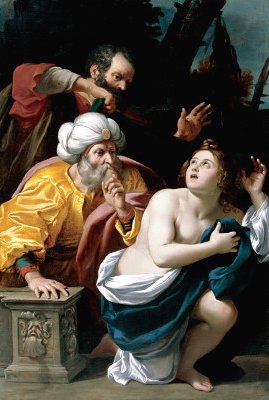 |
|
Susannah and the Elders
Attrib. to Agostino Carracci, Italian 1585-1602
SN 111, Oil on Canvas1600/10
by Robert Anderson.
Artist:
Agostino Carracci was a Bolognese painter and engraver who was the elder brother of the
more famous Annibale Carracci ( 1560-1609) and the cousin of Ludovico Carracci
(1555-1619). The three Carracci's worked together in Rome and Bologna creating a house
style in which their works were sometimes indistinguishable from each other.
Agostino assisted Annibale when the latter was called to Rome to decorate
the Farnese Ceiling in the Cardinal's family palace from 1597 to1600, but was important
primarily as a teacher and engraver. His systematic anatomical studies were engraved after
his death and used for nearly two centuries as teaching aids.
He had studied the great Venetian painters which enabled him to establish
an expressive style based on the northern Italian naturalism and color of Correggio,
Titian and Veronese. His painting can at times be distinguished from Annibale by his
somewhat Raphaelesque sentiment and his less illusionistic rendering of form. Agostino
spent the last two years of his life in Parma where he did his own 'Farnese Ceiling',
decorating a ceiling in the Palazzo del Giardino with mythological scenes. |
The Carracci, spearheaded an artistic reform that overthrew manneristic
aesthetics and can be said to have initiated the Baroque.All three were prominant figures
in the movement against mannerist artificiality in Italian painting.
Their style of painting fell from grace in the 19th century. It was
thought to be ponderous and lacking in originality. By the second half of the 20th
century, however, they had regained their place as giants of Italian painting.
Subject:
This story is found in the Book of Tobit, one of the books of the Apocrypha. The Apocrypha
consisted of books found in Greek translations of the Bible but not found to be a part of
the Hebrew Bible. They were therefore dropped by Luther in his translation and are not
found today in authorized versions of Protestant Bibles.
Susanna was a beautiful and pious woman who was married to a wealthy man
named Joakim who had a beautiful home with a walled garden. It was Susanna's habit to
bathe in the privacy of that garden in the afternoon after all visitors had left. One day
two recently elected elders/judges of the community, after visiting with Joakim, hid in
the garden and watched while Susanna bathed. They then propositioned her with the request
that she have sexual relations with them. If she would not, they said that they would
claim to have seen her making love to another man.
Susannah would not give in and the two elders so testified against her.
The Assembly believed the elders and Susanna was to be put to death when God inspired
Daniel to defend her. Daniel questioned the two elders separately and found discrepancies
in their stories. This was brought to the attention of the Assembly who then declared
Susanna innocent and condemned the two elders to death.
Painting:
The painting shows a partially disrobed Susanna being propositioned by the elders. Her
pose is classical in that it is modeled on a crouching Venus of antiquity. The painting
shows a naturalism and vivid range of emotion-charged expression characteristic of the
baroque. Susanna's round face and the sharper features of the elders are typical of
Agostino's artistry. The use of light effectively highlights Susanna's nudity and the
predatory appearance of the elder's faces which are prominantly emphasized against the
dark background. It almost seems that Susanna is pushing out of the painting toward the
viewer as she cringes away from the menacing and lecherous elders.
This type of painting is typical of betrothal pictures of the period. It
might well have been painted as a gift for the soon to be maried couple. . It presents a
chaste and virtuous wife, and gives an example of the virtuous character that was expected
of the bride by the husband and society.
The painting's exceptional quality makes it one of the supreme examples of
monumental Baroque classicism practiced in the carracci school.
Historical Context:
In Hebrew the name Susanna means a lily, the symbol of purity. She appears in the earliest
Christian art of the Roman catacombs - perhaps as an example to the persecuted of that era
of the final delivery of a righteous person from evil. The Middle Ages made her a symbol
of the Church menaced by Jews and pagans. Medieval artists preferred the theme of Daniel
executing justice, but from the Renaissance onwards they chose Susanna bathing as an
opportunity for the portrayal of female nudity.
|
